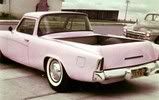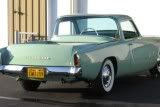Have owned a 1960 Lark VI for about five years now that has given zero problems as far as the motor is concerned. Even made a 1800 miles trip from Texas to Pennsylvania back in June of 2005 without issue one.
Decided to take advantage of the decent weather yesterday and go for a little drive. Reinstalled the battery, checked all the fluids, added a little primer gas and expected it to fire off just like normal - results - nothing.
Pulled plug wire and had my wife turn it over - no spark. Pulled the cap and tested the points - ok spark. Filed points and better but no fire. Removed distributor and put in an extra condenser that was in the glove box with no change. With the motor turning over - points are opening and closing but no spark present.
Did more checking - and I guess I have narrowed it down to the coil - I think. I believe the coil is left over from the previous owners attempt to put in a Pertronix ignition so I think it is the "Flame thrower" coil. Pertronix did not work well at all so it was put back to points and condenser.
Car started and ran without a catch three weeks ago. I have a '62 Champ PU that I can always use for testing parts. (Did this with the starter solenoid with no differences - other than being one wire short on the Lark - only has one elbow connection for the two small threaded posts on the solenoid). Was not sure about the coil because although the truck has a '63 V8 in it, the distributor is the Delco window-type and I think the coil is a Delco as well. Not sure if that would have any difference.
Anyway - just wanted to see what some ideas were. My next step might be as per Gord's suggestions in another post about running a jumper from the + side of the battery to the + side of the coil to see what happens - just have to supply myself with some clips and wire.
Thanks ahead - I know it is difficult trying to diagnose something like this without actually being there.
<div align="left">1960 Lark VI</div id="left"> <div align="right">1962 7E7-122</div id="right">
[img=left]http://i96.photobucket.com/albums/l163/62champ/car/8b0ac4c6.jpg[/img=left]
[img=right]http://i96.photobucket.com/albums/l163/62champ/car/DSC02237.jpg[/img=right]
Decided to take advantage of the decent weather yesterday and go for a little drive. Reinstalled the battery, checked all the fluids, added a little primer gas and expected it to fire off just like normal - results - nothing.
Pulled plug wire and had my wife turn it over - no spark. Pulled the cap and tested the points - ok spark. Filed points and better but no fire. Removed distributor and put in an extra condenser that was in the glove box with no change. With the motor turning over - points are opening and closing but no spark present.
Did more checking - and I guess I have narrowed it down to the coil - I think. I believe the coil is left over from the previous owners attempt to put in a Pertronix ignition so I think it is the "Flame thrower" coil. Pertronix did not work well at all so it was put back to points and condenser.
Car started and ran without a catch three weeks ago. I have a '62 Champ PU that I can always use for testing parts. (Did this with the starter solenoid with no differences - other than being one wire short on the Lark - only has one elbow connection for the two small threaded posts on the solenoid). Was not sure about the coil because although the truck has a '63 V8 in it, the distributor is the Delco window-type and I think the coil is a Delco as well. Not sure if that would have any difference.
Anyway - just wanted to see what some ideas were. My next step might be as per Gord's suggestions in another post about running a jumper from the + side of the battery to the + side of the coil to see what happens - just have to supply myself with some clips and wire.
Thanks ahead - I know it is difficult trying to diagnose something like this without actually being there.
<div align="left">1960 Lark VI</div id="left"> <div align="right">1962 7E7-122</div id="right">
[img=left]http://i96.photobucket.com/albums/l163/62champ/car/8b0ac4c6.jpg[/img=left]
[img=right]http://i96.photobucket.com/albums/l163/62champ/car/DSC02237.jpg[/img=right]


 [IMG]
[IMG] [/IMG]
[/IMG]
Comment